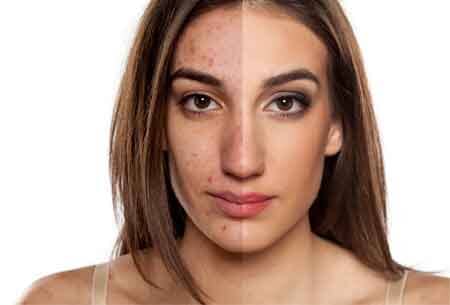Medical Dermatology
MEDICAL DERMATOLOGY
Acne
Acne results when tiny glands beneath the skin surface, the sebaceous glands, become clogged with sebum, an oily substance whose normal collection and excretion keeps the skin healthy. If clogged, bacteria can grow in the glands, which in turn cause swelling and pimples on the skin's surface. This can occur anywhere on the epidermis where there are hair follicles below the surface (the sebaceous glands are attached to these follicles), including the face, back and neck. Acne affects adults as well as teenagers.
Eczema
This is a collective term for a variety of medical conditions that result in the skin being irritated or inflamed. The most common type of eczema is atopic eczema; simply put, this is a group of diseases with a predisposition to other conditions like, hay fever and asthma.

Psoriasis
Psoriasis is a chronic skin condition affecting about six million people in the United States. Small or large round or oval red patches with thick white scales characterize it. These are sometimes itchy and occasionally hurt or bleed but can be asymptomatic, except for the annoyance of shedding flakes of skin.
The most common areas for psoriasis are the elbows, knees and scalp, but it may occur on any part of the body. Five percent of people with psoriasis also have arthritis. The onset of psoriasis can occur at any age including childhood and old age, although it most commonly appears in teens and people in their twenties. Sunlight tends to make it better, whereas alcohol, stress and a lack of sunlight tend to exacerbate this condition.
The most common areas for psoriasis are the elbows, knees and scalp, but it may occur on any part of the body. Five percent of people with psoriasis also have arthritis. The onset of psoriasis can occur at any age including childhood and old age, although it most commonly appears in teens and people in their twenties. Sunlight tends to make it better, whereas alcohol, stress and a lack of sunlight tend to exacerbate this condition.
Vitaligo
Vitiligo is a skin condition that affects the pigmentation of the skin. Patients experience a loss of pigment/brown color from different areas on the skin that appear as uneven white patches. The feel of the skin does not change.
Skin Cancer
Skin cancer refers to the abnormal, uncontrolled growth of skin cells. One in five people will develop skin cancer in their lifetime, according to the American Academy of Dermatology. Fortunately, skin cancer is almost always curable if detected and treated early with regular skin cancer screenings.
All skin cancers appear to be related to sun exposure. The most common skin cancers are:
All skin cancers appear to be related to sun exposure. The most common skin cancers are:
Basal Cell Carcinoma (BCC)
is the most common of all skin cancers. It tends to be slowly growing and frequently appears as a pinkish, translucent, pearly 'pimple' that does not go away on sun damaged skin. It can also look like a scaly patch or resemble a scar.
Squamous Cell Carcinoma tends to be more rapidly growing than BCC. It may also spread especially if located on the ear, forehead, lip and top of the hand. It presents as an enlarging scaly nodule with poorly defined borders that may ulcerate. It may arise from actinic keratosis.
Malignant Melanoma is the fastest growing cancer in the US; its incidences doubling every 10 years. Survival is directly related to early detection since prognosis depends on the tumor thickness. It may spread to the lymph nodes, lung, liver, brain and other skin areas if not discovered and removed surgically in time. Often, the patient will present a change in an existing mole or recognize a new pigmented lesion, which often shows irregular borders, varied colors and recent enlargement.
Squamous Cell Carcinoma tends to be more rapidly growing than BCC. It may also spread especially if located on the ear, forehead, lip and top of the hand. It presents as an enlarging scaly nodule with poorly defined borders that may ulcerate. It may arise from actinic keratosis.
Malignant Melanoma is the fastest growing cancer in the US; its incidences doubling every 10 years. Survival is directly related to early detection since prognosis depends on the tumor thickness. It may spread to the lymph nodes, lung, liver, brain and other skin areas if not discovered and removed surgically in time. Often, the patient will present a change in an existing mole or recognize a new pigmented lesion, which often shows irregular borders, varied colors and recent enlargement.
Abnormal Moles
An abnormal or atypical mole is also known as dysplastic nevus. This type of mole is different from common moles. They are larger, irregular and have unclear borders. The color of the mole ranges from pink to dark brown and are typically flat, but certain parts may be raised above the surface of the skin. Abnormal moles are common in males on the trunk of the torso and on the calves of females.
Rosacea
Rosacea is a chronic skin condition characterized by redness, pimples and in advanced stages, thickened skin.
Rosacea usually occurs on the face, and appears like flushing on the nose, cheeks, forehead and chin. Adult women are affected more often than men by rosacea and its onset might be accompanied by a burning sensation. The skin may also be sensitive to lotions or make-up. There are several ways to treat rosacea. Schedule an appointment with one of our dermatologists to design a plan that works for you.
Rosacea usually occurs on the face, and appears like flushing on the nose, cheeks, forehead and chin. Adult women are affected more often than men by rosacea and its onset might be accompanied by a burning sensation. The skin may also be sensitive to lotions or make-up. There are several ways to treat rosacea. Schedule an appointment with one of our dermatologists to design a plan that works for you.
Warts
Warts are common growths that are caused by the Human Papilloma Virus (HPV). This virus is present in the growths as well as on many surfaces touched by our hands and feet. Frequent touching and picking of warts may cause them to spread. Although some people may have a natural resistance to warts, it is advisable to avoid direct contact with warts on other people and to wear foot protection such as sandals or rubber thongs in places where others go barefoot. Warts may develop on any part of the body including the face, scalp, lip, nose and genital area, as well as on the hands, feet, elbows and knees.
Hyperhidrosis
Coming Soon!
CONTACT INFORMATION
Phone: #dm .f_hcontainer
Email: Operations@dimitri-derm.com
Address: 613 Williams Blvd , Kenner, LA 70065
Email: Operations@dimitri-derm.com
Address: 613 Williams Blvd , Kenner, LA 70065
Address 2: 145 Briant Street, Gretna, LA 70058
Hours of Operation:
Hours of Operation:
| Mon-Fri | 9:00 AM - 5:00 PM |
| Sat-Sun | Closed |
| Saturday Appointments Available at Gretna and Kenner & Every Other Saturday at New Orleans East Medical Disclaimer |
|
BROWSE OUR WEBSITE
CONTACT INFORMATION
Phone: 504-465-4550
Email: Operations@dimitri-derm.com
Address: 613 Williams Blvd , Kenner, LA 70065
Email: Operations@dimitri-derm.com
Address: 613 Williams Blvd , Kenner, LA 70065
Address 2: 145 Briant Street, Gretna, LA 70058
Hours of Operation:
Hours of Operation:
| Mon-Fri | 9:00 AM - 5:00 PM |
| Sat-Sun | Closed |
| Saturday Appointments Available at Gretna and Kenner & Every Other Saturday at New Orleans East Medical Disclaimer |
|
Content, including images, displayed on this website is protected by copyright laws. Downloading, republication, retransmission or reproduction of content on this website is strictly prohibited. Terms of Use
| Privacy Policy

